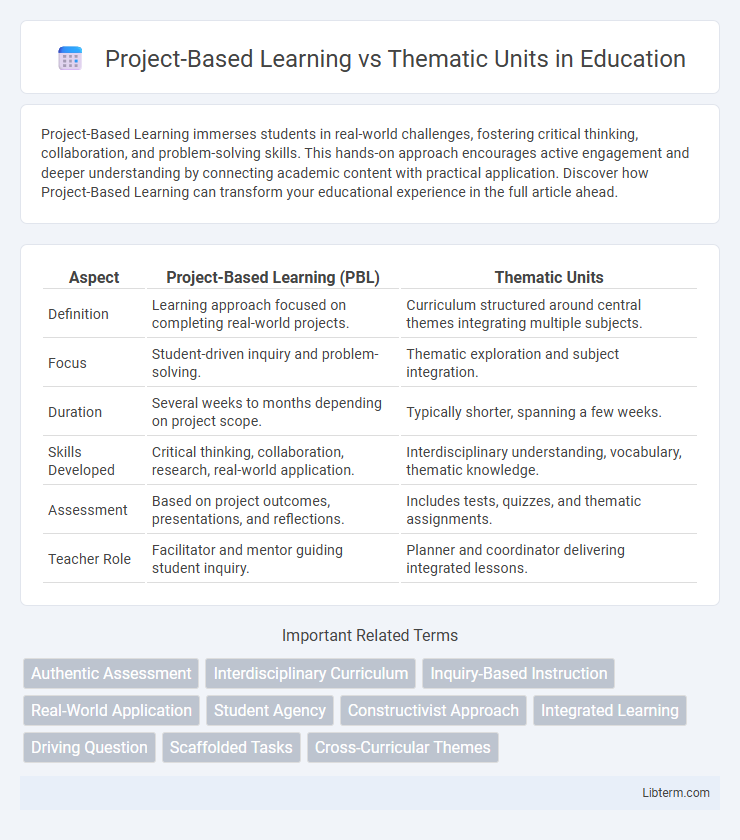Project-Based Learning immerses students in real-world challenges, fostering critical thinking, collaboration, and problem-solving skills. This hands-on approach encourages active engagement and deeper understanding by connecting academic content with practical application. Discover how Project-Based Learning can transform your educational experience in the full article ahead.
Table of Comparison
| Aspect | Project-Based Learning (PBL) | Thematic Units |
|---|---|---|
| Definition | Learning approach focused on completing real-world projects. | Curriculum structured around central themes integrating multiple subjects. |
| Focus | Student-driven inquiry and problem-solving. | Thematic exploration and subject integration. |
| Duration | Several weeks to months depending on project scope. | Typically shorter, spanning a few weeks. |
| Skills Developed | Critical thinking, collaboration, research, real-world application. | Interdisciplinary understanding, vocabulary, thematic knowledge. |
| Assessment | Based on project outcomes, presentations, and reflections. | Includes tests, quizzes, and thematic assignments. |
| Teacher Role | Facilitator and mentor guiding student inquiry. | Planner and coordinator delivering integrated lessons. |
Introduction to Project-Based Learning and Thematic Units
Project-Based Learning (PBL) emphasizes student-centered inquiry through extended investigations, fostering critical thinking and real-world problem-solving skills. Thematic Units organize curriculum around central themes, integrating multiple subjects to create cohesive and meaningful learning experiences. Both approaches enhance engagement and depth of understanding but differ in structure, with PBL focusing on active project completion and Thematic Units on interconnected content exploration.
Defining Project-Based Learning (PBL)
Project-Based Learning (PBL) is an instructional approach where students engage in exploring real-world problems and challenges over an extended period, resulting in a tangible product or presentation. PBL emphasizes student inquiry, collaboration, and critical thinking while integrating various subject areas to enhance deeper understanding. This method contrasts with Thematic Units by centering learning around a student-driven project rather than a predefined theme or topic.
Understanding Thematic Units
Thematic units organize curriculum around central themes that integrate subjects through related concepts, enhancing student comprehension by providing contextual learning experiences. This approach promotes deeper connections between topics, enabling students to apply knowledge across multiple disciplines effectively. Understanding thematic units helps educators design lessons that foster critical thinking, engagement, and retention by linking content to relevant, real-world themes.
Core Principles and Objectives
Project-Based Learning centers on student-driven inquiry, real-world problem-solving, and the integration of cross-curricular skills to foster deep understanding and collaboration. Thematic Units focus on organizing content around central themes, promoting connections between subjects through focused, content-rich exploration that enhances knowledge retention and coherence. Both approaches emphasize active engagement and critical thinking but differ in structure: Project-Based Learning prioritizes outcome-oriented projects, while Thematic Units emphasize thematic coherence and content integration.
Instructional Design Comparisons
Project-Based Learning (PBL) emphasizes student-driven inquiry through real-world projects, fostering critical thinking and collaboration, while Thematic Units organize content around central themes to integrate multiple subject areas. Instructional design for PBL requires scaffolding complex tasks, aligning assessments with project outcomes, and facilitating iterative feedback, whereas Thematic Units focus on cohesive lesson sequences that build thematic understanding across disciplines. Both approaches promote active learning, but PBL demands flexible timelines and resource management, contrasting with Thematic Units' structured pacing and curriculum alignment.
Student Engagement and Motivation
Project-Based Learning (PBL) enhances student engagement by involving learners in real-world problem-solving tasks that require critical thinking and collaboration, leading to increased intrinsic motivation. Thematic Units also boost motivation through interconnected subjects centered around a common theme, fostering deeper understanding and relevance. Research shows PBL often results in higher student ownership of learning, while Thematic Units support sustained interest through holistic content integration.
Assessment Methods in PBL and Thematic Units
Assessment methods in Project-Based Learning (PBL) emphasize authentic evaluation through performance tasks, presentations, and portfolios that measure students' application of knowledge and critical thinking skills. Thematic Units utilize varied formative and summative assessments such as quizzes, reflections, and thematic projects to gauge understanding of interconnected concepts across subjects. Both approaches benefit from rubrics and peer assessments to provide comprehensive feedback aligned with learning objectives.
Benefits and Challenges of Project-Based Learning
Project-Based Learning (PBL) enhances critical thinking, collaboration, and real-world problem-solving skills by engaging students in hands-on, interdisciplinary projects. However, PBL demands significant teacher preparation, ongoing assessment, and resource management, which can pose challenges for consistent implementation. Despite these obstacles, PBL fosters deeper understanding and student motivation compared to traditional thematic units by promoting active, student-centered learning environments.
Advantages and Limitations of Thematic Units
Thematic units offer the advantage of integrating multiple subjects around a central theme, which enhances contextual learning and maintains student engagement by linking content to real-world topics. However, limitations include potential rigidity in curriculum design, making it challenging to address specific learning standards or individual student needs within a fixed thematic framework. Additionally, thematic units may require extensive planning and resources to effectively cover diverse subject matter, which can be time-consuming for educators.
Choosing the Right Approach for Your Classroom
Project-Based Learning emphasizes hands-on, real-world problem solving that fosters critical thinking and collaboration, ideal for classrooms aiming to enhance student engagement through active exploration. Thematic Units integrate multiple subject areas around a central theme, promoting cross-disciplinary connections and deeper content understanding, suitable for educators seeking a cohesive curriculum structure. Selecting the right approach depends on your classroom goals, student needs, and the flexibility required to balance depth of knowledge with practical skill development.
Project-Based Learning Infographic

 libterm.com
libterm.com